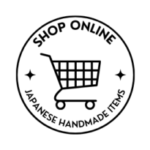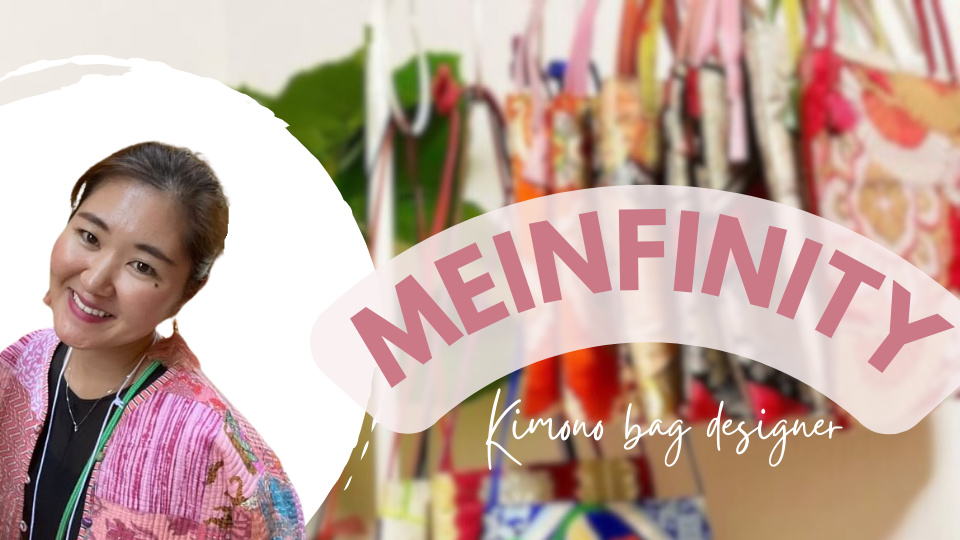
This is an interview article with a handicraft artist who expresses the desire to expand handicraft creations from Japan to overseas. NiJi features many talented artists who are engaged in creative activities with such aspirations. On this page, we will delve deeper into the charm of the affiliated artists and their works. In this first interview, we speak with Akiko, the designer behind the brand 'MEINFINITY', which specializes in bags made from traditional Japanese materials such as kimono and obi.
Follow MEINFINITY Instagram
Q: The beautiful bags with traditional patterns are modern and quite impressive. What inspired you to make bags from kimono and obi fabrics?
In recent years, even as a Japanese person, direct interaction with kimono in daily life has become quite rare. I was one of those who thought, “I’d like to wear it, but it takes time and money, and it’s high-end, so it seems inaccessible. My turning point came when I happened to walk into a recycled kimono store. At that moment, I picked up a kimono and examined it for the first time. Although I had no knowledge about kimonos, I was captivated by the item in my hands and thought, “The pattern of these flowers is incredibly cute! Being ignorant, I didn’t approach it from a traditional perspective, but saw it as a unique design that immediately caught my eye. As I stood in front of the mirror holding an obi I particularly liked, I intuitively felt, “This could be a clutch bag,” and this newfound discovery brought me joy. Without hesitation, I bought obis and haoris and started making bags at home.
Q: Did you have any experience sewing or making small items before, or was this your first venture into such creative work?
I actually had zero skills. The desire to “give it a try” drove me to start from scratch by buying a home sewing machine. Both the sewing machine and kimonos were completely new to me, so I worked on my projects while visiting a kimono shop once a week. The women at the shop shared tips such as, “Since the fabric is thick, it’s better to use denim needles for the sewing machine,” and they provided various insights along with interesting anecdotes. By taking their advice, I was able to shape things little by little.
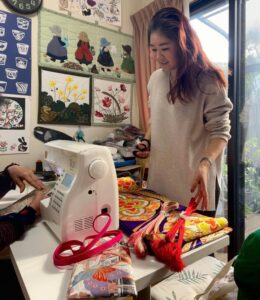
Q: Your proactive approach is really impressive. It started as a hobby, right? Could you share the journey from that hobby to eventually selling your creations?
For the birthday of an American friend who lives in San Francisco, I decided to make a bag as a gift. It was the very first thing I posted on Instagram. At first, it was more of a record for myself, since I had just made it. Looking back, it was a simple creation without a pattern. But at the time, I thought it was quite well done, so I took it to the kimono shop I mentioned earlier. To my surprise, the elderly ladies who were customers there said things like, “Anyone who buys this must be pitiful,” and expressed various negative opinions. I was really upset and thought, “I’m going to prove them wrong
Q: It became one of the driving forces, didn't it? At this stage, were you creating them purely as a hobby, without any thoughts of selling?
Yes, I used to make them as a hobby. Later, I happened to participate in a garage sale and sold my creations for the first time. Art students from an art college happened to be there and were happy to buy them. It brought me great joy to see something I had made being sold and recognized.
After that, as I gradually created more and shared them on Instagram, I received positive reactions from foreigners. Thinking, “Maybe this could work,” I sent them to friends in France, New York, Canada, Thailand, and Korea and asked for their opinions. The responses were very different from those of Japanese people. While the Japanese tended to see the pieces as “kimono patterns,” the foreigners saw them purely as “designs. They appreciated the work without preconceived notions.
In addition, people of mixed Japanese ancestry expressed their happiness by saying that wearing my bags became “part of their identity” and “having something Japanese made them proud. Hearing this, I was convinced that my creations had value beyond just being bags.
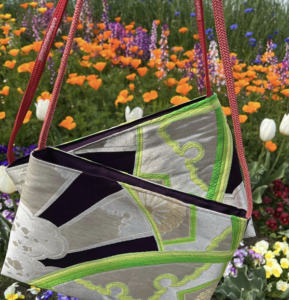
Q: Did you realize the value of your creations from the different reactions in Japan and overseas?
Yes, from this experience, I started a brand to turn it into a business.
So I went to New York, where I had researched and found many foreigners selling kimonos.
I walked around New York every day with my most colorful homemade bag. I approached people who seemed to like Japan, sent DMs to various people, and even attended Japan festivals where Japan enthusiasts gathered.

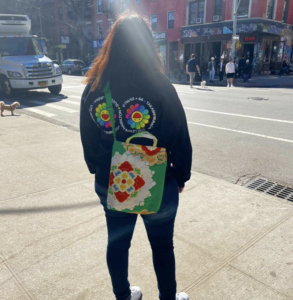
Q: How did you find the differences between Japan and New York?
In Japan, although it may be different for the younger generation, there are generally strict rules regarding kimonos. The patterns vary with the seasons, and there are many times when they cannot be worn. Because of the deep-rooted traditions, many people don’t see them as “fashion.
However, I want to promote these patterns as “designs” and “fashion. That’s why I had to go to America. In New York, I was able to prove that they are accepted with a completely different sensibility than in Japan.
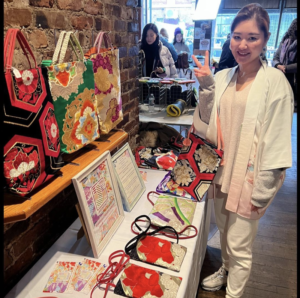
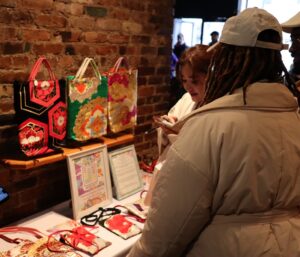
Q: There is a strength in Akiko. What could be the reason for her deep fascination with the charm of kimonos?
Wearing a kimono is like wearing a “Japanese painting”. If you cut out part of the pattern, it is truly art in itself. I am fascinated by kimonos in this way, and to make them more accessible as a fashion, I arrange them in a contemporary style and share them.
Many Japanese people often say, ‘I don’t know how to coordinate it. When I talk to people, many of them express interest in kimonos and want to own one, but the fear of being judged by others acts as a significant barrier; it basically boils down to the idea that it’s difficult to use because others don’t use it. However, foreigners tend to act on what they personally want rather than how others perceive them. It’s as simple as “I think it’s cute, so I’m going to use it.

Q: In this case, would the target audience be international customers?
When I share on social media, a significant number of interested people are foreigners, especially those from Western countries. For the past two years, as I have been shuttling between New York and Japan, I have been acutely aware of the differences in response.
I want to shine where there is demand. In Japan, I received a lot of negative comments. However, considering the drastic change when I moved to New York, I think the first focus should be on expanding internationally.
Q: You are well versed in foreign relations and have many friends living abroad. I am also impressed by your strong ability to take immediate action.
To make my debut overseas at the age of 8, my parents applied for a program organized by Shizuoka Prefecture. We sailed to Saipan and Guam during spring break. Then, in my first year of junior high school, I participated in a student exchange program to Nepal with our sister school. In my second year, I went on an educational trip to Hawaii. Through these experiences, I became aware of the differences between Japan and other countries at a young age.
As a result, I had many questions about unique Japanese rules, such as “Why can’t you dye your hair? “Why are piercings not allowed?” and “Is the discipline of seniors and juniors really necessary?”
Later, as a college student and professional, I continued to travel between Japan and overseas, making use of my experiences abroad. Whenever I go abroad, I always feel a sense of excitement. The more I do, the more acquaintances I make and the more connections I establish. When I am invited by locals, my response is an immediate “Yes!”-I act immediately.
Q: What do you think is the source of the power to take action without hesitation?
When you make decisions and take actions on your own, people around you naturally support you. The ability to act is made possible by the support of cooperative people. From the outside, it may look like I’m doing everything on my own, but it’s really the support of those who agree with me that makes my actions possible.
I also have a rebellious spirit. In response to people who bring negative opinions, I want to show results and prove them wrong.
Q:Lastly, could you share your outlook for the future?
I would like to delve deeper into the world of kimono and materials (fabrics, etc.). While refining my sewing skills with the help of my skilled aunt who is a dressmaker, I am eager to learn more.
In addition, I strive to emphasize the sense of uniqueness, such as the use of high-quality fabrics and threads, and the creation of precious items through special weaving techniques. In addition to focusing on design for international audiences, I plan to incorporate the cherished traditional culture of the Japanese and ensure that each pattern carries a meaningful story.
By showcasing aspects that may go unnoticed if confined to Japan, I hope to prove that they can shine when presented to a global audience. It would bring me great happiness to envision a future where the wonderful traditions and cultures I bring abroad contribute to a significant and widespread impact.

Where can people in the USA buy MEINFINITY kimono bags?
If you are interested in purchasing Japanese handmade products, please have a look at our marketplace!


